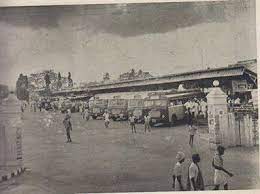Under the Smart City project envisaged by the central government to promote tourism and improvement of infrastructure which will boost the economy of the place, the Thanjavur Municipal corporation has been working hard in the last one and half years or so and making rapid progress as the funds keep coming in instilments. Already the new bus stand complex and Thiruvaiyaru bus stand complex were nearing completion. So was the Ranee's Park (Rajappa Poonga) and the old Clock Tower built from funds provided by the Maratha queen. The present commissioner, being active and energetic, has undertaken several bold steps with a view to giving a impressive facelift to this old city which was in the late 1800s one of the few big towns in the then Madras presidency.
 |
| Digging and foundation work in the place where theater stood. .thehindu.com |
 |
| Thanjavur city location map. mapsofindia.com |
As a senior citizen I know very well prior to 1958 the entire stretch on the south portion of Therkku Alangam (South Rampart) from the old bus stand up to the road close to Cauvery Angadi) on the west (that connects the RM hospital road) was a wide moat - 10 to 15 feet deep covering up to the hospital road.
Do you know where the first bus stand in Thanjavur town was operating? The first ever bus stand with thatched roof supported by thick casuarina wooden poles and 5 to 7 bays (for the buses) was functioning in the place where the Thiruvalluvar theater had stood until it was razed to the ground in the recent past. The buses covered mostly nearby places like Thiruvaiyaru, Vilangudi, Mannargudi and Kumbakonam, etc and only a few buses ran on these routes. We never heard of long-distance buses in those days. It was a small bus stand (right across Bogi Lakshmana Naikar lane) and occasionally one could see buses that ran on coal gas.
 |
| .Thanjavur old bus stand. facebook.com |
Toward 1957-58, the scenario on the south side of South Rampart had changed. The entire moat (Akazhi) area was reclaimed and well levelled with earth filling when late R. Venkatraman was the Industries minister under the Congress regime. The old bus stand with many bays came up in 1959 with modern facilities including Veg and non-veg restaurants and was inaugurated by C M K. Kamaraj Nadar. Sri A.Y. S. Parisutha Nadar was Chairman of Tanjore Municipality and MLA at that time. It was named after Sri Ayyasamy Vandayar, a prominent landlord, congressman and former Municipal Chairman of Tanjore Municipality. It was one of the best well- maintained bus stands in those days.
After 1970s the bus stand came a nasty and chaotic place because of illegal encroachment by shoppers. A few years later a new bus stand came up near the bus stand abetting the RM Hospital road. It was exclusively for express buses covering distant destinations like Madras (Chennai), Madurai, etc. Again it was minister RV who took the initiative to run the long distance government buses for the first time in Tamil Nadu to meet the public demand. Then MLA Sri AYAP. Nadar's contribution to Thnjavur town was vast.
As part of the Smart city project Thanjavur Municipal Corporation (TMC) already initiated the Mall- theater cum parking lot project after demolishing the old Thiruvalluvar theater. The theater itself was in bad shape and the interior was shabby. Part of foundation had already been completed recently.
 |
| .Thanjavur big temple shutterstock.com/ |
While the foundation work was on to build the Mall complex, an unexpected thing had happened and it is about the unearthing of a linear wall which seems to be several centuries old. Heritage enthusiasts now want the project stopped as the structure - wall was the sidewall of a Chola-era moat. This particular project covers 0.70 acres and the Chola era moat, surfaced in the southern boundary of the site.
 |
| .Thanjavur fort area vintage image. facebook.com |
The site is about 700 meters from Brihadeeswara temple built by Chola ruler Raja Rajan in 1010 CE. Also known as Peruvudaiyar temple, it is a UNESCO recognized world heritage site and ''it is a non-combat zone even if there is war." The 50 meter long wall is visible at about 10 feet from the ground level abutting the backyards of commercial establishments on the RM Hospital road. With multiple decks including two layers of stones, “Post-Independence, the moat must have been encroached and buildings raised over it due to ignorance.,'' according to Dr S. Udhayashankar of Chola research group. In Thiruvisaippa, the great siddhar Karur Thevar sang in praise of moat infrastructure.
The TMC has stopped the work temporarily pending enquiry from ASI of Thiruchi circle. Corporation officials feel, the foundation work having been almost completed, shifting the project to a new location is an impossibility.
 |
| / Chola Era wall southram part Thanjavurtimesofindia.indiatimes.com |
The general consensus has been that the heritage of Thanjavur needs to be preserved and at the same time infrastructure like proper long lasting well-laid roads without pot holes, parking spaces in specific areas, etc will help the residents a lot. No doubt, infrastructure development will boost tourism potential and improve the economy of the city.









